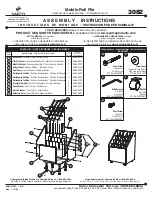
4. Z-Wave manual
7. TIPS AND RECOMMENDATION FOR DCT2RTS interface
• The DCT2RTS interface requires 12-24VDC power. The power cable is connected
to the power terminal (item I) using the screw to fix it.
• To improve the RTS radio range, we recommend the DCT2RTS be placed in an
unconfined place in the middle of the house (avoid metallic surfaces and
enclosures).
• In momentary switch mode, only press one button at a time.
• Tilting motion only apply on 1 channel at one time via DCT interface
• The DCT input must have at least 1.5 second suspension in between successive
RTS commands.
• All DCT input port cannot be connected (short circuit) together. (fig.5)
• Does not support fixed position switch mode and momentary switch mode
simultaneously. See below picture. (fig. 6)
8. TIPS AND RECOMMENDATION FOR Z-Wave2RTS interface
• Before power ON the device, please set the maximum number of RTS channels on
RTS channel selector (item G)
• The Z-Wave2RTS interface requires 12-24VDC power. The power cable is
connected to the power terminal (item I) using the screw to fix it. As an alternative,
power can be supplied through the 5VDC Micro-SUB if the proper adapter is used.
• Supply powers either 12-24VDC or 5VDC micro-USB input port. The device cannot
be operated by both power inputs together.
9. CAUTIONS
• Always remove the micro-USB cable horizontally and gently. Incorrect removal
could cause damage to the USB port.
• The output voltage of micro-USB power adaptor cannot exceed 5VDC @500mA
• The interface must be installed securely in a fixed position which allows a steady
and level USB input.
• Do not install the interface in metal cases as it may affect the radio signal
strength.
• Install the device on the fixed mounting, e.g wall.
• Avoid dust and water, which may damage the device.
• The DCT2RTS interface and Z-WAVE2RTS interface are for internal use only.
• Do not disassemble the unit.
10. ENVIRONMENT
Damaged electric products and batteries should not be disposed of with normal
household waste.
Make sure to drop them in specially provided containers or at an authorized
organization that will ensure they are recycled.
4.1 Z-Wave command Class
Device Type :
Window Covering No Position/Endpoint
Generic Device Class :
GENERIC_TYPE_SWITCH_MULTILEVEL
Specific Device Class :
SPECIFIC_TYPE_CLASS_A_MOTOR_CONTROL
Icon :
ICON_TYPE_GENERIC_WINDOW_COVERING_NO_POSITION_ENDPOINT
6. Technical specification
5. Switch compatibility table
•
Momentary switch (Default mode):
It is only on when the button is pressed. As
soon as you release the button, the circuit is opened.
•
Fixed position switch:
An on/off switch that rocks when pressed, which means one
side of the switch is raised while the other side is depressed much like a rocking
horse rocking back and forth.
# If button pressed over 5 minutes, STOP command will not send.
^ Other option: Press then release UP and DOWN together (~1 sec)
* Each tilting increment is by 0.5 sec/step.
Fig.3 Home automation system directs
connect to DCT2RTS interface wiring
Fig.4 Z-Wave2RTS interface requires
power supply only
3rd parties home automation system
fig.5
fig.6
1. Include/Exclude ZWAVE network
Press the ZWAVE_PROG
button for 3 times.
ZWave2RTS interface send signals to Zwave Hub for
Include/Exclude action.
Z-WAVE LED blinks indicating that the Z-Wave2RTS interface
has been removed from (not joined) the Z-WAVE network.
Z-WAVE LED turns OFF indicating that the Z-Wave2RTS
interface is added the Z-WAVE network.
2. RTS Output Control (Control RTS motors via Zwave Hub)
Binary Switch Set (0xFF)
The blind goes UP.
Binary Switch Set (0x00)
The blind goes Down.
Note: Multi Channel CMD ENCAP V4 Command.
3. MultiChannel Association / Association (Control RTS motors via DCT switch)
Group 1 supports 1 node /
EndPoint
Report ZWave2RTS interface address to ZWAVE Hub (node)
after reset.
Group 2 supports 5 nodes
/ EndPoints
Report DCT status to Hub (node) when DCT port is triggered.
The DCT status feedback send to Hub automatically.
If EndPoint is defined, it will be use MultiChannel Command
to report the DCT status
4. RESET Zwave module to factory mode
Press and hold the ZWAVE_PROG button for 3 seconds after power ON to the ZWave2RTS
interface. All Z-Wave data will be cleared and return to the Inclusion mode
5. Repeater function
ZWave2RTS interface supports standard repeater function for routing (include FLiRS devices).
6. OTA function
ZWave2RTS gateway supports Over The Air (OTA) to upgrade firmware.
COMMAND_CLASS_Z-WAVEPLUS_INFO
COMMAND_CLASS_ASSOCIATION_V2
COMMAND_CLASS_ASSOCIATION_GRP_INFO
COMMAND_CLASS_DEVICE_RESET_LOCALLY
COMMAND_CLASS_FIRMWARE_UPDATE_MD_V2
COMMAND_CLASS_MANUFACTURER_SPECIFIC_V2
COMMAND_CLASS_MULTI_CHANNEL_V4
COMMAND_CLASS_MULTI_CHANNEL_ASSOCIATION_V3
COMMAND_CLASS_POWERLEVEL
COMMAND_CLASS_SWITCH_BINARY
COMMAND_CLASS_SWITCH_MULTILEVEL_V4
COMMAND_CLASS_VERSION_V2
Blind
movement
Fixed position switch
Momentary switch
UP
Press UP
Press then release UP
( 1sec)
DOWN
Press DOWN
Press then release UP
( 1sec)
STOP
Press either UP or Down over
2 sec than release#
Toggle either UP or Down button^
Tilt UP*
NA
Press UP
( 2sec)
Tilt DOWN*
NA
Press DOWN
( 2sec)
Item
Value
Remark
Input voltage (DC input
port)
12VDC – 24VDC
Main power to
DCT2RTS interface or
Z-WAVE2RTS interface
Input voltage (Micro-USB
port)
5VDC
*Optional
Operating current
200mA(max)
Dry contact input (DCT)
voltage
5VDC – 24VDC
Logic HIGH (VDC)
triggers action.
Logic LOW (0V) clears
action.
RTS radio frequency
Range distance
No of channel
No of channel
433.42MHz
20m with 2 concrete walls
5
8
For DCT2RTS interface
(ch1-5)
For Z-Wave2RTS
interface (ch1-8)
Z-Wave radio frequency
Range of distance
868.4 MHz
20m in indoor
EU-frequency
Operating Temperature
0°c to 50°c
Dimension (without cover)
Dimension (with cover)
125mm(L) x 88mm(W) x 30mm(H)
125mm(L) x 105mm(W) x 32mm (H)
Weight
Z-Wave2RTS 138g
DCT2RTS
134g
DC power
12-24VDC
DC power transformer
excluded




















